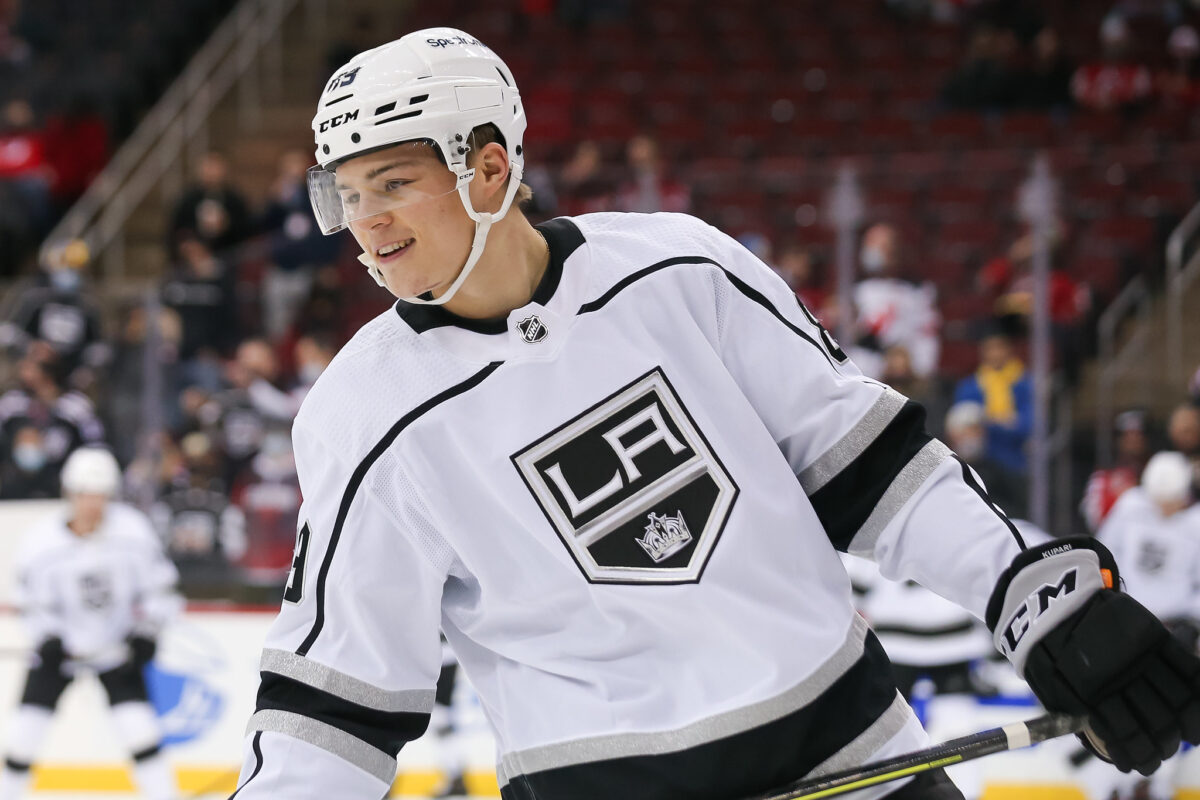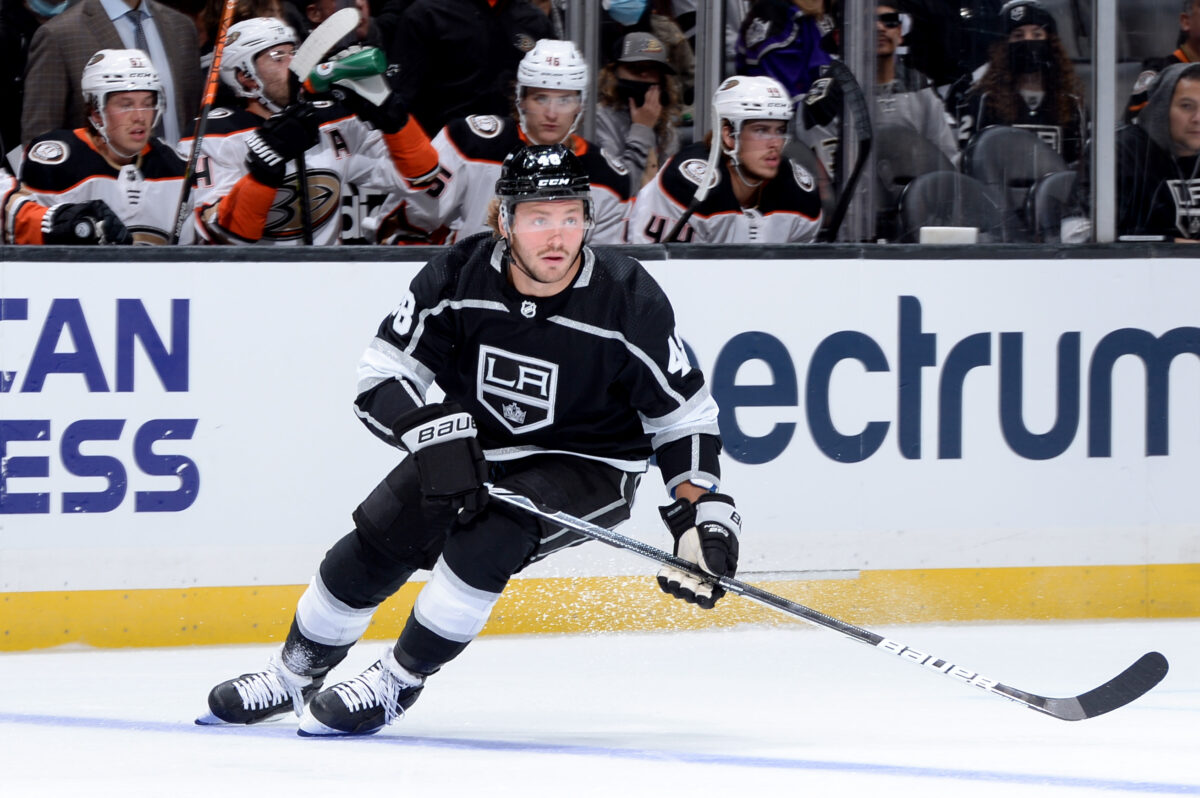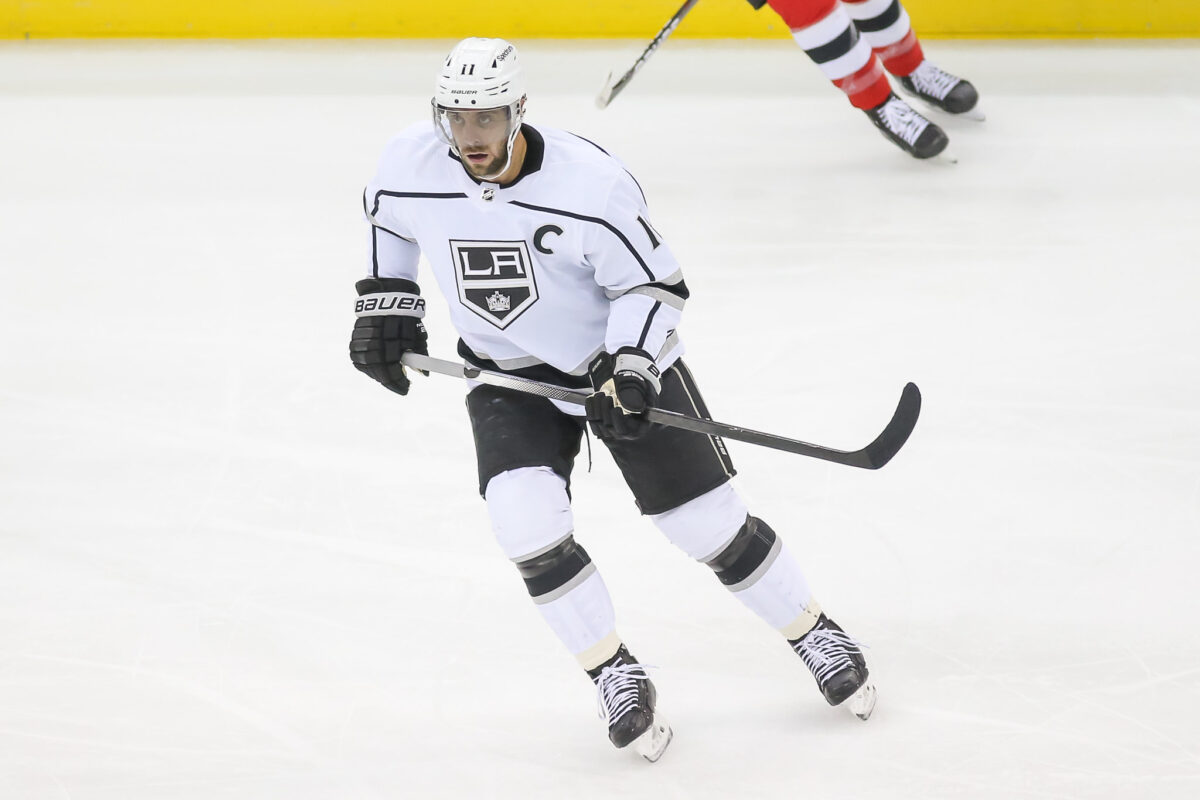After a heavy 6-0 defeat in Game 2, the Los Angeles Kings returned to Crypto.com Arena in Game 3, hoping for a bounce-back performance. The Kings produced everything but, falling 8-2 in another blowout loss to the Edmonton Oilers. Even though it was another six-goal loss, there were at least some positives to take from this game, although this is the time of the season were taking positives from a heavy defeat means very little. Here are three takeaways from the game.
Kids Line Looked Great
A major takeaway from Game 2 was the Kings losing the bottom-six battle, particularly their fourth line that struggled, finishing the game a minus-2. Head coach Todd McLellan was forced into one chance, as he revealed that Carl Grundstrom was injured. In response, he moved Brendan Lemieux into Grundstrom’s spot, replacing Lemieux with Gabe Vilardi on the fourth line, while scratching Quinton Byfield for Rasmus Kupari.
These change made a positive effect, as the fourth line looked significantly better in Game 3, and at times, looked like the team’s most dangerous line. It was the first NHL playoff appearance for both Vilardi and Kupari, who both rose to the occasion. After being recalled from the Ontario Reign in March, Kupari has played a more direct, aggressive game, especially on the foreckeck, and that continued in this game.

There were several questions surrounding how Vilardi would perform in his first playoff game, as the most common criticism of his surrounds the intensity at which he plays. It would have been fair for fans to doubt his ability to step up the pace for the playoffs, as his past performances have not made him seem like the type of player that succeeds in the postseason. There was hope that his end-of-season performance would continue, and while the points weren’t there, he was good once again. From his first shift, he looked engaged and played with pace. He finished the game with two shots, two hits, and an even plus/minus. He also finished with the game’s second-best game impact score according to HockeyStatCards.
Related: Kings Get Dominated by the Oilers in 6-0 Blowout
After a poor Game 2, Arthur Kaliyev came out with a much better Game 3. He was bumped up to the top power-play unit, a change that had a positive impact on that unit, and was better 5v5. I was questioning if he should keep his spot in the lineup after Game 2, but he did enough in Game 3 to keep his spot. Despite no points in this game, the fourth line looked good with flashes of looking great; they even took shifts against the Leon Draisaitl line during this game and held their own. Vilardi was especially impressive, as he proved he can play with pace and intensity. If nothing else, seeing these three players succeed should give fans hope for a great future with this core.
Bottom Six Improved Overall
It wasn’t just the fourth line that struggled in Game 2 and improved in Game 3, the third line also looked much better, finishing the game as the only line to post positive analytics. They provided energy and created chances through relentless forechecking and a willingness to throw pucks on net and battle around the crease. They weren’t able to beat Mike Smith in this game, but they outplayed their opposite number in this game, a huge improvement from Game 2. Scoring depth has been an issue all season for this team and it would be nice to get some production from this line, but it’s hard to complain much about the game they had.

I was a little surprised to see Grundstrom scratched instead of Lemieux, but Lemieux proved coach McLellan right, as he set the tone on that line, relentlessly forechecking and finishing checks all night. They played a “playoff” style of hockey on Friday and it payed off.
Top Six Needs Changes
In Games 1 and 2, the Kings’ top six held their own, and at times outplayed the Oilers’ top six at 5v5. In those games, it was the bottom six and special teams that let the team down, but Game 3 was a different story entirely. The Kings’ top six got dominated, as Anze Kopitar‘s line finished the game a combined minus-9, while Phillip Danault’s line finished the game a combined minus-7. Such a poor game is especially uncommon for the Danault line, which normally can at least keep goals out of their own net.
It’s hard to criticize Danault and Kopitar, who scored both of the Kings’ goals, with Kopitar grabbing two points total, but I do worry that fatigue is setting in. McLellan heavily leaned on these two in the first two games, and they did a great job of keeping Connor McDavid and Draisaitl relatively quiet at 5v5, but I’m worried they’ve been worn out a bit. It will be interesting to see how they do in Game 4, as McLellan might have to trust his bottom six to play more minutes if these two are indeed fatiguing.

Of course, Kopitar and Danault aren’t the only ones who make up the top six and certainly aren’t the only ones struggling, either. All four wingers in the top six were poor in Game 3. Trevor Moore, Alex Iafallo, Adrian Kempe, and Andreas Athanasiou all had poor games, and McLellan has to think about shuffling his wing pairings. There are several options, especially after establishing that several bottom-six players looked good in Game 3. Kings’ insider John Hoven of Mayor’s Manor had a good suggestion on Twitter.
I like these lines, but I’d be less drastic in my changes. Assuming that both Grundstrom and Viktor Arvidsson, who McLellan revealed is suffering from a lower-body injury, are both still injured, here’s how I’d like the lines to look.
| Adrian Kempe | Anze Kopitar | Gabriel Vilardi |
| Trevor Moore | Phillip Danault | Alex Iafallo |
| Brendan Lemieux | Blake Lizotte | Dustin Brown |
| Rasmus Kupari | Quinton Byfield | Arthur Kaliev |
Seeing Athanasiou go from the top line to healthy scratched seems harsh, but he hasn’t done much to warrant his spot in the lineup and someone needs to be left off. This lineup rewards Vilardi for his play, while taking some of the playmaking burden off Kopitar’s shoulders. Kempe and Athanasiou are both great rush players, but they aren’t exceptional passers and rely on other players for creativity, leaving Kopitar with a lot of work offensively. Adding Vilardi to this line gives Kopitar relief, while also leaving a shot threat on both wings. I also want to see how Byfield responds to his scratch. In reality, this team needs him to gain experience in the postseason. Also, having him in the press box didn’t change the outcome of Game 3, so scratching him doesn’t seem to help anyone.
We’ve seen Byfield and Kaliyev find success together in the past, and Kupari can add skill, speed, and effective forechecking to their line. While the Kings absolutely should not give up on this series, and there’s every possibility they come back, they also need to be realistic about what these playoffs can offer them. They aren’t a Cup contender, and players like Byfield, Kaliyev, Vilardi, and Kupari gaining vital experience for the future helps them more than anything. Based on Game 3, Kaliyev, Kupari, and Vilardi are more than capable of competing as well, so they won’t be throwing anything away by giving them more minutes.
Kings Can Take Positives From Tough Loss
Anytime you lose a game 8-2, it’s hard to see any positives; however, the Kings can take some from this game. Their young fourth line looked good, signaling that future success is very possible for this Kings team. They also saw improvements from their third line, despite a lack of goals from them. They need to make changes to the top six, but if that involves moving one of the young players into an elevated role, it can also be seen as a positive. These players will need to step up if the Kings plan on competing anytime soon, and now’s a good time to give them that opportunity.